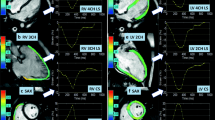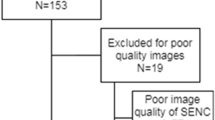Abstract
Cardiac magnetic resonance imaging is an important tool to evaluate cardiac anatomy and ventricular size and function after repaired tetralogy of Fallot. Magnetic resonance tissue tagging is the gold standard for evaluation of myocardial strain. However, myocardial tagging strain requires tagged images to be obtained prospectively, during the scan and with limited temporal resolution. Cardiac magnetic resonance feature tracking is a new tool that allows the retrospective analysis of cine images. There is limited experience with cardiac magnetic resonance feature tracking strain analysis in children. The medical records of patients with repaired tetralogy of Fallot that had a cardiac magnetic resonance (CMR) study from December 2013 to June 2015 were reviewed. The control group included patients who underwent a CMR with normal cardiac anatomy and ventricular function. Global longitudinal, circumferential and radial strain parameters (2D and 3D) were obtained by retrospectively contouring cine images from ventricular short axis, two chamber and four chamber views using post-processing software (Circle CVi42, Calgary, Canada). The correlation between conventional ventricular function parameters and ventricular strain was performed using Pearson’s correlation. The mean age of tetralogy of Fallot and control subjects was 12.4 and 14.1 years, respectively. In patients after repaired tetralogy of Fallot, the mean left ventricular global 2D and 3D circumferential strains were −17.4 ± 2.9 and −10.1 ± 3, respectively. The mean indexed right ventricular end-diastolic volume was 135.4 cc m2 ± 46 compared to 75.7 cc m2 ± 17 in control subjects (P = 0.0001, CI 95%). Left ventricular global circumferential 3D strain showed a statistically significant difference in patients after TOF repair compared to normal subjects (−10.1 ± 3 vs. −14.71 ± 1.9, P = 0.00001). A strong correlation between left ventricular global circumferential 3D strain and right ventricular end-diastolic volume (P ≤ 0.0001) was noted. We found a strong correlation between left ventricular circumferential 3D strain and indexed right ventricular end-diastolic volume, as well as a strong correlation between left ventricular longitudinal 2D strain and right ventricular ejection fraction. Circumferential 3D strain may be a suitable tool to detect early abnormalities of ventricular myocardium even before the ejection fraction becomes compromised. Large-scale prospective studies are recommended.




Similar content being viewed by others
Abbreviations
- CMR:
-
Cardiac magnetic resonance
- CMR-FT:
-
Cardiac magnetic resonance feature tracking
- LV:
-
Left ventricle
- RV:
-
Right ventricle
- iLVESV:
-
Indexed left ventricular end-systolic volume
- iLVEDV:
-
Indexed left ventricular end-diastolic volume
- iRVESV:
-
Indexed right ventricular end-systolic volume
- iRVEDV:
-
Indexed right ventricular end-diastolic volume
- LVEF:
-
Left ventricle ejection fraction
- RVEF:
-
Right ventricle ejection fraction
- GRS:
-
Global radial strain
- GCS:
-
Global circumferential strain
- GLS:
-
Global longitudinal strain
- 2D:
-
Two-dimensional
- 3D:
-
Three-dimensional
- rTOF:
-
Repaired tetralogy of Fallot
References
Kellenberg CJ, Yoo SJ, Büchel ER (2007) Cardiovascular MR imaging in neonates and infants with congenital heart disease. Radiographics 27(1):5–18
Ntsinjana HN, Hughes ML, Taylor AM (2011) The Role of cardiovascular magnetic resonance in pediatric congenital heart disease. J Cardiovasc Magn Reson 13(1):51
Mi-Young J, Germain P, Pierre Croisille, Ghannudi S, Roy C, Gangi A (2012) Myocardial tagging with MRI imaging: overview of normal and pathologic findings. Radiographics 35(5):1381–1398. doi:10.1148/rg.325115098
Clark NR, Reicheck N, Bergey P, Hoffman EA, Browson D, Palmon L, Axel L (1991) Circumferential myocardial shortening in the normal human left ventricle. Assessment by magnetic resonance imaging using spatial modulation of magnetization. Circulation 84:67–74
Chen SM, Keegan J, Dowsey A, Ismail T, Wage R, Li W, Yang GZ, Firmin D, Kilner P (2011) Cardiovascular magnetic resonance tagging of the right ventricular free wall for the assessment of long axis myocardial function in congenital heart disease. J Cardiovasc Magn Reson 13:80
Fogel MA, Gupta KB, Weinberg PM, Hoffman EA (1995) Regional wall motion and strain analysis across stages of Fontan reconstruction by magnetic resonance tagging. Am J Physiol 269:H1132–H1152
Fogel MA, Gupta KB, Baxter BC, Weinberg PM, Haselgrove J, Hoffman EA (1996) Biomechanics of the deconditioned left ventricle. Am J Physiol Heart Circ Physiol 271:H1193–H1206
MA Fogel, Weinberg PM, Fellows KE, Hoffman EA (1995) A study in ventricular–ventricular interaction. Single right ventricles compared with systemic right ventricles in a dual-chamber circulation. Circulation 92:219–230
Fogel MA, Weinberg PM, Gupta KB, Rychik J, Hubbard A, Hoffman EA, Aselgrove J (1998) Mechanics of the single left ventricle: a study in ventricular–ventricular interaction II. Circulation 98:330–338
Donofrio MT, Clark BJ, Ramaciotti C, Jacobs ML, Fellows KE, Weinberg PM, Fogel MA (1999) Regional wall motion and strain of transplanted hearts in pediatric patients using magnetic resonance tagging. Am J Physiol Regul Integr Comp Physiol 277:R1481–R1487
Khalaf A, Tani D, Tadros S, Madan S (2013) Right and left ventricular strain evaluation in repaired pediatric tetralogy of Fallot patients using magnetic resonance tagging. Pediatr Cardiol 34:1206–1211. doi:10.1007/s00246-013-0631-6(11)
Lu JC, Connelly JA, Zhao L, Agarwal PP, Dorfman AL (2014) Strain measurement by cardiovascular magnetic resonance in pediatric cancer survivors: validation of feature tracking against harmonic phase imaging. Pediatr Radiol 44:1070–1076. doi:10.1007/s00247-014-2992-2(12)
Hor KN, Baumann R, Pedrizzetti G, Tonti G, Gottliebson WM, Taylor M, Benson W, Mazur W (2011) Magnetic resonance derived myocardial strain assessment using feature tracking. J Vis Exp 48:2356
Hor KN, Gottliebson WM, Carson C, Wash E, Cnota J, Fleck R, Wansapura J, Klimeczek P, Al-Khalidi HR, Chung ES, Benson DW, Mazur W (2010) Comparison of magnetic resonance feature tracking for strain calculation with harmonic phase imaging analysis. JACC Cardiovasc Imaging 3:144–151. doi:10.1016/j.jcmg.2009.11.006
Khan JN, Singh A, Nazir SA, Kanagala P, Gershlick AH, McCann G (2015) Comparison of cardiovascular magnetic resonance feature tracking and tagging for the assessment of left ventricular systolic strain in acute myocardial infarction. Eur J Radiol 84:840–848
Andre F, Henning S, Matheis P, Weskott M, Breuninger K, Yannick S, Kammerer R (2015) Age- and gender related normal left ventricular deformation assessed by cardiovascular magnetic resonance feature tracking. J Cardiovasc Magn Reson 17:25. doi:10.1186/s12968-015-0123-3
Shuster A, Stahnke V, Unterberg-Buchwald C, Kowallick JT, Lamata P, Steinmetz S, Kutty S, Fasshauer M, Staab W, Sohns JM, Bigalke B, Ritter C, Hasenfu BG, Beerbaum P, Lotz J (2015) Cardiovascular magnetic resonance feature-tracking assessment of myocardial mechanics: intervendor agreement and considerations regarding reproducibility. Clin Radiol 70(9):989–998
Pedrizzetti G, Sengupta S, Caracciolo G, Park CS, Amaki M, Goliasch G, Narula J, Sengupta P (2014) Three-Dimensional principal strain analysis for characterizing subclinical changes in the left ventricular function. J Am Soc Echocardiogr 27(10):1041–1050
Therrien J, Siu SC, McLaughlin PR, Liu PP, Williams WG, Webb GD (2000) Pulmonary Valve replacement in adults late after repair of tetralogy of Fallot: Are we operating too late? J Am Coll Cardiol 36:1670–1675
Kempny A, Diller GP, Orwat S, Kaleschke G, Kerchhoff G, Ach Bunck, Maintz D, Baumgartner H (2012) Right ventricular-left ventricular interaction in adults with Tetralogy of Fallot: a combined cardiac magnetic resonance and echocardiographic speckle tracking study. Int J Cardiol 154(3):259–264
Broberg CS, AboulhosnJ Mongeon FP, Kay J, Valente AM, Khairy P, Earing MG, Opotowsky AR, Lui G, Gersony DR, Cook S, Ting JG, Webb G, Gurvitz MZ (2011) Prevalence of left ventricular systolic dysfunction in adults with repaired tetralogy of Fallot. Am J Cardiol 107:1215–1220
Ghai A, Silversides C, Harris L, Webb HD, Siu SC, Therrien J (2002) Left ventricular dysfunction is a risk factor for sudden cardiac death in adults late after repair of tetralogy of Fallot. J Am Coll Cardiol 40(9):1675–1680
Dumesnil JG, Daubert JC, Erdmann E, Freemantle N, Gras D, Kappenberg L et al (1979) A mathematical model of the dynamic geometry of the intact left ventricle and its application to clinical data. Circulation 59:1024–1034
Carlsson M, Ugander M, Mosen H, Buhre T, Arheden H (2007) Atrioventricular plane displacement is the major contributor to left ventricular pum** in healthy adults, athletes and patients with dilated cardiomyopathy. Am J Physiol Heart Circ Physiol 292:H1452–H1459
Ersboll M, Valeur N, Mogensen UM, Andersen MJ, Moller JE, Velasquez EJ et al (2013) Prediction of all-cause mortality and heart failure admissions from global left ventricular longitudinal strain in patients with acute myocardial infarction and preserved left ventricular ejection fraction. J Am Coll Cardiol 61:2365–2373
Riffel JH, Andre F, Maertens M, Rost F, Keller MGP, Giusca S, Seitz S, Kristen AV, Muller M, Giannitsis E, Korosoglou G, Katus HA, Buss SJ (2015) Fast assessment of long axis strain with standard cardiovascular magnetic resonance: a validation study of a novel parameter with reference values. J Cardiovasc Magn Reson 17:69
Taylor RJ, Moody WE, Umar F, Edwards NC, Taylor TJ, Stegemann B, Townend JN, Hor KN, Steeds RP, Mazu W, Leyva F (2015) Myocardial Strain measurement with feature-tracking cardiovascular magnetic resonance: normal values. Eur Heart J 16:871–881
Khalaf A, Tani D, Tadros S, Madan S (2013) Right and Left ventricular strain evaluation in repaired pediatric tetralogy of Fallot patients using magnetic resonance Tagging. Pediatr Cardiol 34:1206–1211
Lipiec P, Wisniewski J, Kasprzak JD (2014) Should we search for linear correlations between global strain parameters and ejection fraction? Eur Heart J Cardiovasc Imaging 15(11):1301
Kempny A, Fernandez-Jimenez R, Orwat S, Schuler P, Bunck AC, Maintz D, Baumgartner H, Diller GP (2012) Quantification of biventricular myocardial function using cardiac magnetic resonance feature tracking, endocardial border delineation and echocardiographic speckle tracking in patients with repaired tetralogy of Fallot and healthy controls. J Cardiovasc Magn Reson 14:32
Acknowledgements
We are grateful to all staff involved in the care of our study subjects at Driscoll Children’s Hospital. We would also like to thank Jose H. Guardiola Ph.D., Department of Mathematics and Statistics, Texas A&M University for his collaboration on the statistical analysis.
Authors Contribution
FMB gathered study information, analyzed the data and wrote the manuscript. CGdA also contributed equally and made substantial contributions to writing of the manuscript, data analysis and bibliography background. DA contributed to the research idea, and also in charge of the clinical MRI reporting and post-processing of cine images for feature tracking. NO and DA were involved in the data analysis and edition of the final manuscript.
Author information
Authors and Affiliations
Corresponding author
Ethics declarations
Conflict of interest
The authors declare that they have no conflict of interest to disclose.
Rights and permissions
About this article
Cite this article
Berganza, F.M., de Alba, C.G., Özcelik, N. et al. Cardiac Magnetic Resonance Feature Tracking Biventricular Two-Dimensional and Three-Dimensional Strains to Evaluate Ventricular Function in Children After Repaired Tetralogy of Fallot as Compared with Healthy Children. Pediatr Cardiol 38, 566–574 (2017). https://doi.org/10.1007/s00246-016-1549-6
Received:
Accepted:
Published:
Issue Date:
DOI: https://doi.org/10.1007/s00246-016-1549-6




